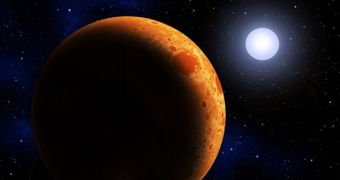Astronomers are currently keeping a close eye on the evolution of an interesting binary star system, which features two white dwarfs. The two objects are apparently about to merge, an event that will lead to the formation of a new, living stellar object.
White dwarfs are the helium-burning remnants of Sun-sized stars that have reached the end of their burning cycle, exhausted their hydrogen supplies, expanded into red giants, and then shed the outer layers of their atmosphere.
They are fossils basically, but they can endure in this state for up to 3 billion years, before finally whizzing out of existence. But apparently these objects can get a new lease on life under some very specific conditions, most often when they are found in binary systems.
What this means is that they are revolving around each other, or around a common center of gravity. If they stray too close to each other, they they combine, or merge, to form a new stellar object.
The way this happens is by their material stirring up again, and reigniting thermonuclear fusion reactions. But this can only be accomplished if the objects are spiraling ever closer to each other.
“These stars have already lived a full life. When they merge, they'll essentially be 'reborn' and enjoy a second life,” explains Harvard-Smithsonian Center for Astrophysics (CfA) astronomer and study researcher Mukremin Kilic.
Measurements indicate that the binary system, called SDSS J010657.39–100003.3, can be found about 7,800 light-years away, in the constellation Cetus, which is relatively nearby in astronomical terms.
At this point, the two stars whirl at a distance of about 140,000 miles (225,000 kilometers) away from each other, which means that their mutual gravitational pulls are already beginning to change their spherical appearance.
Experts estimate that this binary system will give birth to a new star within less than 37 million years, Space reports. If the two white dwarfs were heavier, their merger would have resulted in tremendously powerful supernova explosions, but this is not the case with SDSS J010657.39–100003.3.
Kilic says that he and his team are currently working on identifying even more binary star systems in the Milky Way. Our galaxy is – for the most part – made up of stars similar in mass to the ones in this interesting binary system.
“There should be many such systems in the galaxy,” Kilic concludes.

 14 DAY TRIAL //
14 DAY TRIAL //